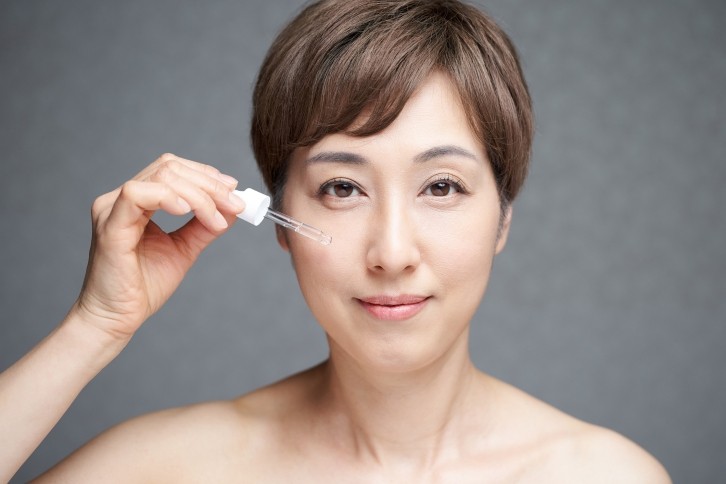Peptide power: Multi-peptide eye serum improves skin appearance around the eyes

The multiple peptides used in the serum include acetyl hexapeptide-8, palmitoyl tetrapeptide-7, palmitoyl tripeptide-1, and dipeptide-2.
The serum was used twice daily for 28 days by women with visible signs of ageing, namely wrinkling and sagging.
Researchers from Tianjin and Beijing, China, posited that anti-ageing products require a multi-targeted mechanism to tackle the signs, as skin ageing is caused by multi-dimensional factors – spanning intrinsic from genetics, hormones, and time to extrinsic factors such as UV exposure, pollution, and a poor diet.
Key findings
The objective assessment showed a significant reduction in wrinkles (p<0.0001) noted by day 14 of product use and maintained until day 28.
The authors defined the objective assessment of wrinkles as follows: “In this study, wrinkle characterization indicated a statistically significant decrease in the number, depth, and volume of skin deformations from the baseline of product use.”
Despite no significant changes in skin hydration or elasticity, subjective reporting from some participants showed an improvement in hydration (p = 0.149).
Subjective reporting from participants also showed that most were satisfied with the elasticity, firmness, and smoothness of their skin after 14 days of product use, but the satisfaction slightly decreased by day 28.
“While statistical significance is achieved in objective assessments of lines and wrinkles, the magnitude of change may not be sufficient as subjects did not rate these very high in satisfaction,” the paper stated.
However, the reporting for wrinkles reduction was consistent (40.63% on day 14 and 46.88% on day 28). Participants were also generally pleased with the product applicability and extensibility throughout the study period. No adverse events were also reported.
Mechanism at work
The multi-peptide eye serum was provided by cosmetics manufacturer UNILIPO company.
It claimed to contain 10% Argireline® (acetyl hexapeptide-8), 4% Matrixyl® 3000 (palmitoyl tetrapeptide-7, palmitoyl tripeptide-1), and 2% Eyeliss™ (dipeptide-2, palmitoyl tetrapeptide-7, hesperidin methyl chalcone) as effective ingredients.
Explaining the mechanism at work, the authors stated: “The active ingredients of the serum used in this study are signal peptides, neurotransmitter-inhibiting peptides, enzyme inhibitor peptides, and other functional peptides. The anti-wrinkle effects of this serum can be attributed to multiple different mechanisms.
“Palmitoyl tetrapeptide-7 increases skin firmness, smoothness, and elasticity by reducing the IL-6 and dipeptide-2 levels; additionally, it reduces eye edema by regulating blood microcirculation. Thus, it improved skin firmness and reduced the appearance of fine lines and wrinkles in this study.
“However, no significant skin-hydration improvement was observed here, possibly due to insufficient moisturizing factors in the product that inadequately protected the skin surface from moisture loss.”
Study design
The results were based on a clinical trial study done on 32 Asian women aged 20 to 45 years with naturally aged skin.
They were directed to apply approximately 0.5ml of the serum on the eye-area twice a day – one in the morning and on in the evening.
Skin biophysical parameters of the subjects were taken at day 0 after cleansing their faces, day 14 and day 28 of product use.
For objective measurements, the researchers utilised the Corneometer CM825 and Skin Elastometer MPA580, respectively, to assess for skin hydration and skin elasticity. For wrinkle analysis, the skin image around the “crow’s feet” area was obtained using a digital strip projection technology, known as the PRIMOS CR technique.
For subjective reporting, the participants were asked to self-assess the anti-ageing effects of the product in a satisfaction questionnaire at day 14 and day 28. The results were then analysed using the SPSS software.
The researchers highlighted the implications of the results and where future research should address:
“This study provides critical insights that could facilitate the development of effective anti-aging products based on the mechanisms of aging and skin structure.
“However, larger multicenter controlled trials, other trials including middle-aged and men, and longitudinal studies are required to elucidate and validate the conclusions drawn from this study.”
Source: Journal of Cosmetic Dermatology
“Clinical evidence of the efficacy and safety of a new multi-peptide anti-aging topical eye serum”
DOI: 10.1111/jocd.15849
Authors: Li, F., et al.










![[Getty Images]](/var/wrbm_gb_food_pharma/storage/images/_aliases/wrbm_tiny/publications/cosmetics/cosmeticsdesign-asia.com/china/china-focus-latest-developments-in-china-s-booming-beauty-market22/17370102-1-eng-GB/China-focus-Latest-developments-in-China-s-booming-beauty-market.jpg)
![YSL's LoveShine launch has sparked a demand surge in Japan. [YSL]](/var/wrbm_gb_food_pharma/storage/images/_aliases/wrbm_tiny/publications/cosmetics/cosmeticsdesign-asia.com/article/2024/04/24/ysl-loveshine-launch-propels-lip-gloss-sales-to-record-highs-in-japan-since-2020/17372064-1-eng-GB/YSL-LoveShine-launch-propels-lip-gloss-sales-to-record-highs-in-Japan-since-2020.jpg)
![There is significant scope for innovation and new launches in the hair repair sector, especially in soaring markets such as China. [Getty Images]](/var/wrbm_gb_food_pharma/storage/images/_aliases/wrbm_tiny/publications/cosmetics/cosmeticsdesign-asia.com/article/2024/04/24/croda-zeroes-in-on-hair-repair-solutions-as-damage-hair-concerns-surge-in-markets-like-china/17362731-1-eng-GB/Croda-zeroes-in-on-hair-repair-solutions-as-damage-hair-concerns-surge-in-markets-like-China.jpg)



![Lubrizol has extended its partnership with C-beauty major PROYA. [PROYA]](/var/wrbm_gb_food_pharma/storage/images/_aliases/wrbm_tiny/publications/cosmetics/cosmeticsdesign-asia.com/headlines/brand-innovation/lubrizol-bullish-on-potential-of-c-beauty-growth-potential/17362515-1-eng-GB/Lubrizol-bullish-on-potential-of-C-beauty-growth-potential.jpg)


